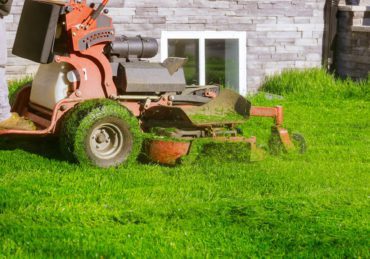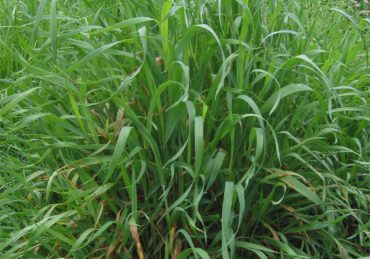You should stop watering your lawn in the fall when temperatures consistently drop below 50°F, signaling reduced moisture needs. Look for signs of dormancy, such as browning grass and stunted growth, as well as ground freezing, which inhibits moisture absorption. It’s also important to monitor local frost dates to determine when to cease irrigation. Gradually reduce watering frequency while ensuring your lawn receives 1 to 1.5 inches of moisture weekly until freezing occurs. Avoid overwatering to prevent fungal diseases and nutrient deficiencies. For more insights on effective fall lawn care, consider what else needs attention before winter arrives.
Why Watering Your Lawn in Fall Matters
Watering your lawn in the fall is essential for promoting healthy growth and recovery before winter dormancy. While adequate hydration supports the establishment of cool-season grasses and enhances nutrient absorption, it’s equally important to be mindful of the risks associated with overwatering. Striking the right balance guarantees a resilient lawn that can endure the challenges of winter and thrive in the spring.
Benefits of Fall Watering
Maintaining proper hydration in your lawn during the fall is vital for promoting recovery from summer stress and preparing for the upcoming winter dormancy. Fall watering is essential for establishing a healthier lawn, as it enables grass to recover fully and strengthens root systems. When you water your grass adequately during this season, you encourage deeper root growth, enhancing resilience against future drought conditions. Furthermore, proper hydration helps cool-season grasses thrive, providing natural defenses against weeds in the spring. Following recommended guidelines of 1 to 1.5 inches of water weekly can greatly reduce watering needs in the spring, ensuring your lawn remains lush and vibrant. Ultimately, effective fall watering practices lead to a thriving landscape year-round.
Risks of Overwatering in Fall
Excessive watering during the fall can severely undermine lawn health, leading to a cascade of issues that compromise the integrity of the grass and its root system. Overwatering prevents roots from accessing essential nutrients, resulting in yellow grass and nutrient deficiencies. Furthermore, excessive soil moisture creates a favorable environment for fungal growth, increasing the risk of diseases that can damage your lawn. Thatch buildup from overwatering can suffocate roots, inhibiting healthy growth and weakening the lawn. In addition, stagnant water attracts pests, further threatening lawn health. Effective lawn maintenance requires careful monitoring of soil moisture levels to prevent overwatering, ensuring that the lawn remains resilient and capable of withstanding drought conditions in subsequent seasons.
When to Stop Watering Your Lawn in Fall
As temperatures consistently drop below 50°F, it’s essential to assess your lawn’s watering needs. Signs of dormancy, such as browning grass, indicate that watering can be reduced or ceased. Furthermore, increased rainfall and lower evaporation rates during fall further inform the timing of when to stop irrigation.
Temperature Drops Below 50°F Consistently
Consistently dropping temperatures below 50°F serve as a clear indication that it is time to reduce lawn watering frequency. As grass growth slows in response to these cooler temperatures, it becomes increasingly unnecessary to water your lawn regularly. When nighttime temperatures approach the low 30s, the ground can freeze, preventing effective moisture absorption. Consequently, it is advisable to begin decreasing your watering schedule. With the first frost typically occurring around late November, this marks the vital point to stop watering altogether to prevent waterlogging and root damage. Monitoring soil moisture is essential during this period; consistently damp soil combined with cold temperatures may lead to fungal issues, making effective fall lawn care important for maintaining a healthy lawn.
Grass Shows Signs of Dormancy
Observing the grass for signs of dormancy, such as browning and reduced growth, becomes increasingly important as temperatures drop and indicate the need to adjust your watering routine. When nighttime temperatures fall below 50°F, it is a clear signal to stop watering your lawn. Furthermore, if the ground becomes frozen, watering is ineffective, as moisture cannot penetrate the soil. It’s advisable to monitor local frost dates and consider ceasing irrigation by the third week of November in most regions, or sooner in frost-prone areas. Recognizing these signs of dormancy confirms that your lawn remains healthy through seasonal changes while preventing overwatering, which can lead to disease and root issues.
Increased Rainfall and Reduced Evaporation Rates
Increased rainfall during the fall season often provides adequate moisture for lawns, greatly reducing the necessity for supplemental watering. As temperatures cool, evaporation rates decrease, allowing soil moisture to persist longer. This natural hydration can often eliminate the need to water, particularly when consistent rainfall occurs. Monitoring local weather patterns is essential; if the soil remains damp in the upper layers after rain, it is advisable to stop watering the lawn altogether. Furthermore, with nighttime temperatures dropping into the low 30s, grass growth slows, further indicating reduced watering needs. Homeowners should assess soil moisture regularly and adjust their watering practices accordingly to promote a healthy lawn while preventing potential overwatering issues.
How Much Should You Water Your Lawn in Fall?
As temperatures begin to drop in the fall, it is essential to gradually reduce your lawn’s watering schedule to prevent over-saturation. Ideally, your lawn should receive 1 to 1.5 inches of water per week, which can be achieved through two 30-minute watering sessions if rainfall is insufficient. Monitoring soil moisture and adjusting your watering habits accordingly will help maintain peak health for your lawn as it prepares for dormancy.
Gradually Reduce Watering
To promote healthy lawn growth during the fall, it is essential to gradually reduce watering, aiming for a total of 1 to 1.5 inches of moisture per week while closely monitoring local rainfall and temperature changes. As temperatures decrease, adjust your watering frequency accordingly, ideally providing two 30-minute sessions per week. This practice encourages deeper root growth and increases resilience to colder conditions. It is crucial to monitor soil moisture to prevent overwatering, which can cause disease and root complications. Utilize a rain gauge to accurately measure water application, ensuring your lawn receives the recommended amount without excess. By managing these factors, you can maintain a robust lawn throughout the fall season.
Ideal Watering Amounts Before Dormancy Sets In
Adjusting watering practices as temperatures decrease is essential for ensuring your lawn receives the ideal moisture amounts before dormancy sets in during the fall season. Aim to provide a total watering amount of 1 to 1.5 inches per week, including rainfall, to maintain optimal soil moisture. Established lawns typically require watering 2 to 3 times per week, particularly if natural precipitation is insufficient. To maximize water efficiency, conduct deep watering sessions early in the morning, ideally two 30-minute sessions per week. Regularly monitor your lawn’s moisture using a rain gauge, adjusting your watering schedule accordingly to prevent overwatering and drought stress. By managing these factors, you can promote a healthy lawn as it prepares for winter dormancy.
Regional Variations for Fall Lawn Watering
Regional climate variations greatly influence when homeowners should cease watering their lawns in the fall. In colder regions, the first frost date typically signals the end of irrigation by late October to early November, while warmer areas may continue watering until early December. Homeowners must consider local weather patterns, such as temperature drops and rainfall amounts, to determine the appropriate cessation time. Lawns in drier climates often require more frequent manual watering, contrasting with those in wetter regions where natural rainfall may suffice. Moreover, geographic factors like soil type and drainage play an essential role in how quickly the ground absorbs moisture, further impacting the timing and frequency of watering cessation in the fall.
Shutting Down Your Irrigation System for Winter
As temperatures begin to drop, it is vital to shut off your sprinklers and irrigation systems to prevent potential damage from freezing water. Winterizing your irrigation system involves removing all water from pipes and fittings to guarantee peak function when spring arrives. Timely and proper winterization not only protects your investment but also prepares your lawn care equipment for the upcoming growing season.
When to Shut Off Sprinklers and Irrigation Systems
To guarantee the longevity of your irrigation system, it is crucial to shut off sprinklers and properly winterize the system before freezing temperatures set in. The ideal time to stop watering your grass is before the first freeze, typically in late November in many regions. Proper winterization is necessary to prevent frozen water from damaging pipes.
| Action | Timing | Purpose |
|---|---|---|
| Shut off irrigation system | Before first freeze | Prevent pipe damage |
| Blow out system | Before freezing temperatures | Remove standing water |
| Inspect for leaks | Fall | Identify issues early |
| Drain valves | Before winter | Guarantee complete drainage |
| Schedule spring activation | Late winter | Prepare for next season |
Winterizing Your Irrigation System
Preparing your irrigation system for winter is vital to prevent damage from freezing temperatures and guarantee its longevity. Winterizing your irrigation system involves making certain that all water left in the pipes is completely removed to avoid freezing and subsequent damage. This process can include using an air compressor to blow out the system or activating the automatic drain feature. It is essential to complete winterization before the first freeze date, typically around late November in many regions. Neglecting this step can lead to cracks and bursts, resulting in costly repairs. If you are uncertain about the winterization process, consider hiring professional winterization services to make sure your system is adequately protected against harsh winter conditions.
Additional Fall Lawn Care Tips to Prepare for Winter
Effective fall lawn care is vital for ensuring a healthy and resilient lawn as it shifts into the winter months. Begin by aerating your lawn to enhance soil health and nutrient absorption, ideally before overseeding to maximize results. Apply a slow-release fertilizer in early fall to support grass growth, preparing it for dormancy. Maintain regular watering, ensuring your lawn receives 1 to 1.5 inches of water per week until the ground freezes, which is essential for hydration. Furthermore, raking or mulching fallen leaves helps improve airflow and reduces fungal diseases during the winter months. Finally, address any weeding and complete overseeding before the first frost to encourage a thicker, healthier lawn come spring.
Frequently Asked Questions
When Should You Stop Watering a Lawn in the Fall?
Determining the appropriate time to cease lawn watering is essential. Monitor for consistent freezing temperatures, signs of dormancy, and local climate conditions to guarantee ideal soil moisture without risking overwatering, which may lead to detrimental lawn health issues.
Does Grass Need to Be Watered in Fall and Winter?
Grass requires hydration in fall to recover from summer stress and establish roots for winter dormancy. In winter, watering may be necessary in milder climates, but generally, it should be reduced substantially or ceased entirely.
When Should You Stop Watering Plants in the Fall?
Determining when to stop watering plants in the fall depends on temperature fluctuations and moisture levels. Monitor for consistent cooling, reduced growth, and rainfall, adjusting your watering routine to prevent overwatering and promote plant health.
When in the Fall Should You Stop Mowing Your Lawn?
As autumn’s chill creeps in, the grass whispers its final goodbye. Mow your lawn until consistent frost appears, typically by late November, ensuring a tidy finish while preventing debris that suffocates your lawn’s winter slumber.





